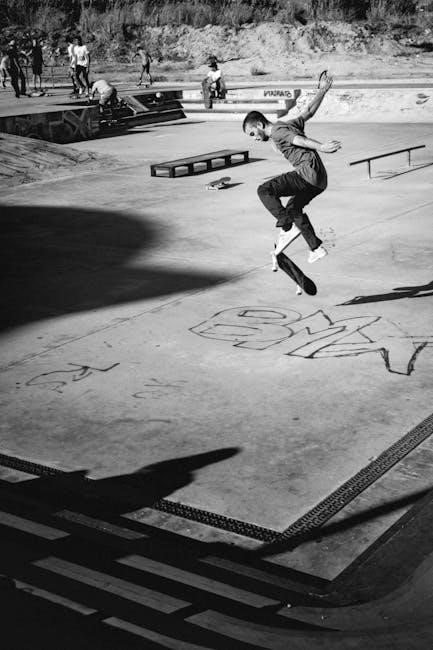
The PhET Energy Skate Park simulation is an interactive learning tool designed to explore energy conservation principles. Users can design tracks, adjust variables like mass, friction, and gravity, and observe energy transformations between kinetic, potential, and thermal forms. The simulation provides visual graphs and tools to enhance understanding, making it a powerful resource for STEM education. It aligns with curriculum standards and is widely used in classrooms to engage students in hands-on learning experiences.
1.1 Overview of the Simulation
The PhET Energy Skate Park simulation offers an engaging environment to explore energy principles. Users design tracks, adjust variables like mass and friction, and observe energy transformations. The simulation displays kinetic, potential, and thermal energy in real-time, providing interactive graphs and tools. It serves as a dynamic platform for visualizing energy conservation, ideal for educational settings to enhance STEM learning experiences.
1.2 Purpose and Educational Value
The PhET Energy Skate Park simulation is designed to teach energy conservation principles through interactive exploration. It helps students visualize transformations between kinetic, potential, and thermal energy, fostering deeper conceptual understanding. The simulation aligns with STEM education standards, making it a valuable tool for classrooms. Its engaging nature enhances student interest and supports teachers in creating dynamic, inquiry-based lessons.

Key Features of the Energy Skate Park Simulation
The simulation offers adjustable variables like mass, friction, and gravity, enabling exploration of energy types (kinetic, potential, thermal) and interactive tools like track builders and energy graphs.
2.1 Adjustable Variables (Mass, Friction, Gravity)
In the PhET Energy Skate Park simulation, users can adjust the skater’s mass, friction levels, and gravity settings to observe their effects on energy transformations. These variables allow for a deeper understanding of how different factors influence the distribution of kinetic, potential, and thermal energy within the system. This feature enhances the simulation’s educational value by enabling controlled experiments.
2.2 Energy Types (Kinetic, Potential, Thermal)
The simulation visualizes three energy types: kinetic, potential, and thermal. Kinetic energy is associated with motion, potential energy with height, and thermal energy with friction losses. As the skater moves, the simulation displays real-time changes in these energies, helping users understand how energy transforms and is conserved. This interactive representation simplifies complex physics concepts for learners.
2.3 Interactive Tools (Track Builder, Energy Graphs)
The simulation offers a Track Builder tool, enabling users to create custom tracks with ramps and jumps, allowing exploration of energy transformations in various scenarios. Energy Graphs provide visual representations of kinetic, potential, and thermal energy over time, helping users analyze and compare energy distribution. These tools make complex concepts accessible and engaging for learners of all levels.
The Importance of the Energy Skate Park Worksheet

The worksheet guides students in applying simulation data to questions, reinforcing energy conservation concepts and promoting deeper understanding through structured inquiry and analysis of energy transformations.
3.1 Guided Learning Through Simulation
The Energy Skate Park worksheet complements the simulation by guiding students through interactive exploration. It encourages learners to adjust variables like mass, friction, and gravity, observing how these affect energy transformations. By analyzing kinetic, potential, and thermal energy graphs, students connect theoretical concepts with visual data, fostering a deeper understanding of energy conservation principles in an engaging, hands-on environment.
3.2 Reinforcing Energy Conservation Concepts
The worksheet enhances understanding of energy conservation by prompting students to analyze transformations between kinetic, potential, and thermal energy. Through structured questions, learners track energy changes, exploring how variables like friction and mass influence energy distribution. This hands-on approach reinforces the principle that total energy remains conserved, even as it shifts between forms, aligning with fundamental physics concepts.
Variables in the Energy Skate Park Simulation

The simulation allows adjustment of mass, friction, and gravity, enabling exploration of their impact on energy transformations and system behavior, enhancing conceptual understanding through experimentation.
4.1 Mass of the Skater
The mass of the skater can be adjusted using a slider, allowing users to observe its impact on energy transformations. Increasing the skater’s mass affects both kinetic and potential energy levels, as more mass results in greater energy storage. This feature helps students visualize how varying mass influences energy distribution and conservation principles in different scenarios within the simulation.
4.2 Friction Settings
The simulation allows users to adjust friction levels, demonstrating its role in energy loss. Higher friction reduces kinetic energy and increases thermal energy, while lower friction minimizes energy loss. This feature helps students understand how friction impacts energy conservation and transformation, aligning with real-world scenarios where energy efficiency is influenced by frictional forces. It enhances the simulation’s educational value by providing practical insights.

4.3 Gravity Levels
Gravity levels in the simulation can be adjusted to observe their impact on energy transformations. Increasing gravity accelerates the skater, converting potential energy into kinetic energy faster. Lower gravity reduces acceleration, slowing the energy transfer. This feature demonstrates how gravitational forces influence motion and energy distribution, offering insights into real-world physics principles and their application in dynamic systems. It enhances the simulation’s educational depth and engagement.

Understanding Energy Types in the Simulation
The simulation focuses on three energy types: kinetic, potential, and thermal. It visualizes how these energies transform and interact, aiding students in understanding their roles and interplay in dynamic systems.
5.1 Kinetic Energy
Kinetic energy in the simulation represents the energy of motion. It increases as the skateboarder moves faster and decreases when friction or other forces slow them down.
The simulation’s energy graph and bar charts allow users to track kinetic energy changes, providing a clear visual representation of energy transfer during motion.
5.2 Potential Energy
Potential energy in the simulation is the stored energy an object has due to its height. As the skateboarder moves upward, potential energy increases, visualized by the energy graph and pie chart. At the crest of a ramp, all kinetic energy is converted to potential energy, demonstrating energy conservation principles effectively.
5.3 Thermal Energy
Thermal energy in the simulation represents energy lost due to friction, converting kinetic and potential energy into heat. As the skateboarder moves, friction generates thermal energy, visible in the energy graph and pie chart. This demonstrates how energy is dissipated, emphasizing the importance of friction in real-world energy transfer scenarios.

Conservation of Energy in the Simulation
The simulation illustrates the principle of energy conservation, showing how energy transforms between kinetic, potential, and thermal forms without loss. Total energy remains constant.
6.1 Energy Transformation Scenarios
The simulation allows users to observe energy transformations as the skateboarder moves. Kinetic energy converts to potential energy when ascending ramps, while descending transfers potential back to kinetic. Friction introduces thermal energy, showing real-world energy loss; Adjustable variables like mass and gravity demonstrate how these factors influence energy distribution, providing a dynamic visualization of conservation principles in action. Graphs and bar charts track these changes for deeper analysis.
6.2 Demonstrating Energy Conservation
The simulation illustrates energy conservation by showing that the total energy remains constant, despite transformations between kinetic, potential, and thermal forms. As the skateboarder moves, energy shifts but isn’t created or destroyed. Adjusting variables like friction and mass reveals how energy distribution changes, while the total energy graph confirms conservation, providing a clear visual demonstration of this fundamental physics principle.
Step-by-Step Guide to Using the Simulation
Open the PhET Energy Skate Park simulation.
Select the “Intro” tab to begin.
Choose a 60 kg skater and adjust gravity to the center.
Enable speed and path tracking.
Select the second track and expand the energy graph.
Place the skateboard at the top left and release to observe energy transformations.
Adjust variables like friction to explore energy conservation.
Analyze the energy graph to understand kinetic, potential, and thermal energy shifts.
7.1 Initial Setup and Settings
To begin, launch the PhET Energy Skate Park simulation and select the “Intro” tab. Choose a skater mass of 60 kg for consistency. Adjust the gravity slider to the middle position and ensure the speed and path tracking options are enabled. Select the second predefined track and expand the energy graph to view kinetic, potential, and thermal energy distributions. This setup provides a clear starting point for exploring energy transformations.
7;2 Running and Analyzing the Simulation
Release the skateboard and observe its motion along the track. Use the energy graph to monitor kinetic, potential, and thermal energy levels in real-time. Pause the simulation at key points, such as peaks and valleys, to analyze energy transformations. Take note of how friction and gravity affect energy distribution. This hands-on approach helps visualize and understand energy conservation principles effectively.

Answering the Energy Skate Park Worksheet Questions
Use simulation data to answer questions about energy transformations and conservation. Analyze graphs, calculate energy values, and explain concepts like kinetic, potential, and thermal energy changes.
8.1 Identifying Key Energy Concepts
Identify and recognize kinetic, potential, and thermal energy within the simulation. Use energy graphs and pie charts to visualize transformations and apply these observations to worksheet questions. This step reinforces understanding of energy types and their interrelations, enabling accurate analysis of how energy shifts during the skater’s movement. Relate simulation data to theoretical concepts for precise answers.
8.2 Applying Simulation Data to Questions
Analyze and apply data from the simulation to answer worksheet questions accurately. Capture specific energy measurements, observe trends in energy graphs, and interpret transformations. Use these insights to explain concepts like energy conservation and transfer. Relate simulation observations to theoretical principles, ensuring answers are supported by data. This step reinforces the practical application of energy conservation principles and enhances problem-solving skills.

The Role of Friction, Gravity, and Mass in Energy Transfer
Friction, gravity, and mass significantly influence energy distribution. Friction converts kinetic energy to thermal energy, while gravity affects potential energy. Mass impacts kinetic and potential energy calculations, demonstrating their interconnected roles in energy transfer dynamics.
9.1 Impact of Friction on Energy Loss
In the simulation, friction reduces the skateboarder’s kinetic and potential energy, converting it into thermal energy. As friction increases, the skateboard slows down, and energy transitions from kinetic to thermal forms. This demonstrates how friction acts as a dissipative force, highlighting energy loss and its role in real-world energy transfer scenarios.
9.2 Effect of Gravity on Potential Energy
Gravity significantly influences potential energy in the simulation, as it determines the skateboarder’s height-related energy storage. Increasing gravity accelerates the skateboarder downhill, converting potential energy into kinetic energy more rapidly. This demonstrates how gravitational force affects energy transformation, providing insights into the relationship between height, mass, and energy distribution in dynamic systems.
9.3 Influence of Mass on Energy Calculations
Mass directly impacts the skateboarder’s energy distribution. A heavier skater possesses greater kinetic and potential energy due to increased mass. However, the total mechanical energy remains consistent if friction is absent. Adjusting mass demonstrates how energy scales with it, while friction introduces thermal energy loss, showcasing the balance between mass, motion, and energy transformation in the simulation.
Advanced Topics in the Energy Skate Park Simulation
Explore energy efficiency, thermal energy dynamics, and advanced track designs. Analyze how friction and gravity affect energy transfer in complex scenarios, enhancing deeper understanding of energy principles.
10.1 Thermal Energy and Its Significance
Thermal energy represents the internal energy of a system due to molecular motion. In the simulation, it illustrates energy loss from friction, converting kinetic and potential energy into heat. By adjusting friction levels, users can observe how thermal energy accumulation affects the skater’s motion, providing insights into energy dissipation and its role in real-world systems. This feature enhances understanding of the second law of thermodynamics and energy conservation principles.
10.2 Exploring Energy Efficiency
The simulation demonstrates energy efficiency by showing how friction and other factors influence energy loss. By minimizing friction and optimizing track designs, users can maximize the skater’s motion while reducing thermal energy dissipation. This highlights the importance of efficient energy transfer in real-world systems, aligning with principles of energy conservation and mechanical efficiency.

Real-World Applications of the Simulation Concepts
The simulation’s concepts apply to real-world scenarios like roller coaster design, bicycle efficiency, and architectural planning, where understanding energy conservation and loss is crucial for optimization.
11.1 Energy Conservation in Daily Life
The simulation highlights how energy conservation principles apply to everyday situations, such as designing energy-efficient systems, understanding energy loss in vehicles, and optimizing appliance performance. These concepts encourage practical applications of energy management, promoting sustainability and resource efficiency in real-world scenarios. By exploring these connections, users gain a deeper appreciation for the importance of energy conservation in their daily lives and global contexts.
11.2 Practical Examples of Energy Transfer
The simulation illustrates energy transfer through real-world analogies, such as roller coasters converting potential to kinetic energy or bicycles losing energy through heat. These examples mirror the skateboarder’s energy transformations, demonstrating how energy shifts between forms in everyday systems. Such practical connections help learners apply theoretical concepts to tangible scenarios, enhancing their understanding of energy dynamics and efficiency in various mechanical processes.
The PhET Energy Skate Park simulation effectively teaches energy conservation through interactive exploration, making complex concepts engaging and accessible for students of all levels.
12.1 Summary of Key Takeaways
The PhET Energy Skate Park simulation is a dynamic tool for exploring energy conservation, offering insights into kinetic, potential, and thermal energy transformations. By adjusting variables like mass, friction, and gravity, users can observe how energy shifts and dissipates, reinforcing core physics concepts. The simulation’s interactive nature and visual graphs make complex ideas accessible, fostering deeper understanding and engagement in STEM education.
12.2 Final Thoughts on the Simulation’s Effectiveness
The PhET Energy Skate Park simulation is a valuable resource for teaching energy conservation and transformation concepts. Its interactive and visual approach makes complex physics accessible to students. By allowing users to adjust variables and observe real-time energy changes, it fosters a deeper understanding of kinetic, potential, and thermal energy. The accompanying worksheet further reinforces learning, making it an effective tool for STEM education.